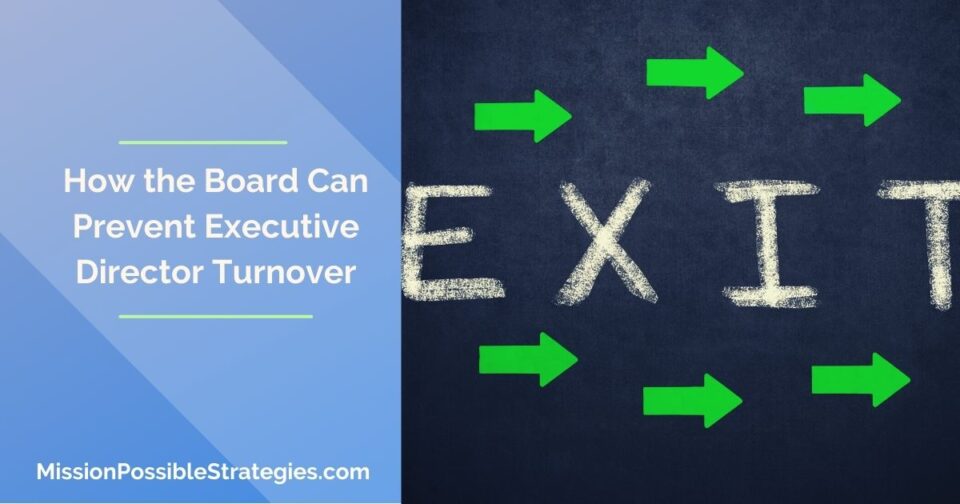This post discusses why nonprofit executive director turnover is so high and how the board can help.
The turnover rate for nonprofit executive directors is 18% to 22% annually. Nonprofit Board Members can expect to navigate a leadership transition every 4- 5 years.
On average, it takes 7 to 10 months to recruit a new Executive Director. Over a year may pass before the new ED is fully on board.
This is grim news for nonprofits.
Strong management is a leading factor for organizational success and the cost of undesired turnover is high. Finding, recruiting, and training a new ED can cost up to half an annual salary.
All of this begs a fundamental question: Why do executive directors leave?
Some studies cite low pay and long hours. These are certainly key factors and I don’t want to minimize them. But I think another key reason is the emotional exhaustion caused by 5 factors:
1. Your identity becomes intertwined with your job.
As an ED, you can never truly “let go” because you represent something that is bigger than yourself. Your actions are tied to an entity whose reputation is yours to protect.
The line between your personal and professional life blurs, and it can be hard to tell which relationships are personal and which are tied to your work. It’s hard to separate the part of you that isn’t the Executive Director of XYZ Nonprofit.
The small piece of your mind that is always “on” creates a slow energy leak that eventually causes fatigue. In order to sustain yourself, you must carve out and protect personal space.
2. You are rarely alone, but you often feel lonely.
Despite the social nature of their jobs, many EDs feel extremely isolated, even those who have very good relationships with their board, key partner organizations, and staff members.
Because of the power dynamics of being the boss, it’s difficult to have friendships at work. The long hours and exhaustion at the end of the day also make it hard to find or maintain a romantic relationship.
It’s essential to invest time in building an outside group of co-supportive peers. Just keep in mind that the stronger and healthier you are as a person, the better you will be as an ED.
3. It’s exhausting to constantly have to inspire people.
It takes emotional energy to recruit board members, motivate staff, and woo donors to invest in the vision. When you live and believe in something with all of your being, it can be offensive when people seem uninterested.
Having to relay the same story over and over again about your agency’s mission can be tiring. Conversations will bleed into one another, and it can be hard to remember who has heard a specific story. Scheduling “off” days where you don’t have to give your elevator speech can help.
4. You have to make tough choices.
Sometimes, large donors or important community influencers want to dictate decisions. You have to choose between sabotaging critical relationships and your personal and professional values.
Sometimes decisions are loaded, and whatever choice you make will upset or disappoint someone. Often, you have to sacrifice the battle to win the war. Or you have to make decisions without all relevant information in order to act in a timely fashion.
Often your tough choices will be based on information that you can’t share with others. Sometimes you will have to fire people you love. Sometimes good choices feel bad, and sometimes you will make bad choices and have to own them. Talking to other EDs or a coach can help.
5. You’re partially responsible for recruiting and training your boss.
Let’s face it, the board and ED dynamic is unusual, even if everyone involved has the best intentions. Some consultants maintain that the ED and Board Chair are co-pilots who share duties. This is a good concept, in theory.
But even if the board chair is doing her part in recruiting and training board members, the ED still has a lot of responsibilities in this area.
I can’t think of any other profession in which an employee recruits, motivates, and trains her boss. And I can’t name any other profession in which an employee usually reports to a boss who doesn’t have experience working in the industry.
Also, in many circumstances, the ED’s job performance depends on the board’s performance. But board members are volunteers, and as the ED, you have no authority to insist they fulfill their responsibilities.
The resulting power dynamic, which some consultants call the “board/ED dance,” can leave you feeling vulnerable. Again, sharing your feelings with other EDs or a coach can be beneficial. And working on open communication with your board chair is essential.
According to BoardSource, one of the key responsibilities of nonprofit boards is to choose, evaluate, and support the executive director. I think board members choose and evaluate the ED, but often fail to provide support due to a lack of understanding of the difficulties of the ED position. In the face of these challenges, coaching and mentoring can provide a powerful, cost-effective strategy for developing, supporting, and retaining current and future leaders.
Summary: Board members can make sure their executive director is set up for success by providing support and professional development in the early years. Some boards fear that leadership development investments will walk out the door but recent research suggests the opposite. Staff members who feel their growth is supported stay longer than those who don’t.
And remember…You’re not alone. You can do this!
SOURCES:
No One Told Us! The Unspoken Challenges of Being an Executive Director, Rebecca Fishman Lipsey, Contributor, Huffington Post
“Nonprofit Executive Director Turnover: Not If, But When,” https://jjco.com/2019/06/15/nonprofit-executive-director-turnover-not-if-but-when/
“Nonprofit Leadership Development Programs: Filling the Nonprofit Leadership Gap,” https://www.missionbox.com/article/46/nonprofit-leadership-development-programs-filling-the-nonprofit-leadership-gap


